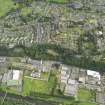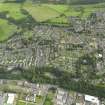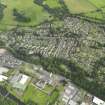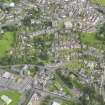Selkirk, Station Road, Forest Mill
Engine House (19th Century), Mill (19th Century), Tweed Mill (19th Century)
Site Name Selkirk, Station Road, Forest Mill
Classification Engine House (19th Century), Mill (19th Century), Tweed Mill (19th Century)
Alternative Name(s) Shepherds Mill; Roberts Mill; Forrest Mill; Hogg's Factory (Spinning); Nottingham Manufacturing Co; Messrs George Roberts And Co
Canmore ID 54250
Site Number NT42NE 51
NGR NT 46720 28792
Datum OSGB36 - NGR
Permalink http://canmore.org.uk/site/54250
- Council Scottish Borders, The
- Parish Selkirk
- Former Region Borders
- Former District Ettrick And Lauderdale
- Former County Selkirkshire
NT42NE 51 46720 28792
In the period 1902-1914, Forest Mill was one of the premier mills in the Scottish Woollen Industry. But in the wake of the Great War, Forest Mill had, like many others, lost it's principal markets in Europe. As the steady but inexorable decline set in, an effort to concentrate the more profitable mills was launched in 1960. Thus in 1962, George Roberts and Company merged with Robert Noble, Hawick and Walter Thorburn, Peebles. After a brief success, this venture failed, with the result that the weaving interests of the group were sold to Henry Ballantyne, Walkerburn. Following this failure, the weaving mill at Forest Mill was closed in 1967, the wool store and spinning sections following in 1973, when operations were transferred to the company's mill in Huddersfield. Two years on, in 1975, the mill in Huddersfield was finally sold to the Nottingham Manufacturing Company.
Information taken from "The Little Guide to Selkirk Mills", c. 2000
On the Forest Mill site was previously built Hogg's Factory. A spinning mill, built c. 1771, it was owned by James Rodger and William Rodger. Hogg's used the bleaching fields of Kilncroft and Bleachfield.
Information taken from "The Little Guide to Selkirk Mills", c. 2000
Messrs Roberts have the reputation of using superior wools, which of course gives a character to their goods. Messrs Roberts were also the first to introduce the self acting mule.
Writing in 1868, Bremner also noted that this company had, within "the last two years", erected a powerful steam engine, their water supply having found to be inadequate to their needs.
Finally Bremner notes, that Messrs Roberts have a mill in Innerleithen for spinning yarn which is worked up into tweeds at their mill in Selkirk.
D Bremner, 1969
Roberts of Selkirk, renown for their fine Scottish tweeds, introduced silk strips of great complexity to their clothes.
Information taken from Butt and Ponting, 1987
Erected in 1838, with additions in 1868. The four storey block was topped off by a bellcote.
Information taken from C A Strang, 1994
Part of a complex of single and multi-storey mill buildings, whinstone rubble with sandstone ashlar dressings. Slate roofs. 4-pane fixed and casement windows. 4-storey and double attic, almost square-plan, 5-bay sides and 2-bay gables with dummy stacks. 6th stair bay projects at SE with narrower windows, piended roof and diminutive octagonal bellcote. External unenclosed lift cage. 3 tiers of skylights. INTERIOR: timber floors on single row of stout cast-iron columns simply supporting timber cross beams. Belt driven lift. Vertical drive shaft and bevel gears survive throughout, as does horizontal line shafting on upper floors. Double collar beam attics.
For George Roberts and Co, who pioneered cheviot cloth and, it is claimed by Bremner, were the first in the area to adopt the self-acting mule. The reputation for quality was outstanding. George Roberts and his brother Tom, both of Galashiels, visited the USA and returned with the first condensers. George became provost of Selkirk and chairman of the Selkirk-Galashiels Railway Company. Sons John and Tom Roberts pioneered the import of Australian and New Zealand wool to the Borders. Forest Mill served as the wool store, dyehouse and weaving mill for the firm. Spinning was conducted at St Ronan's Mill, Innerleithen, Philiphaugh Mill, Selkirk (from 1872), and Earlston Mill. Merged 1962 with Robert Noble of Hawick and Walter Thorburn of Peebles. Weaving mill closed 1967, and the remainder in 1973. Weaving was since been restarted by S Elliot and the remainder of the complex is used for a variety of small industrial and retail purposes. (Historic Scotland)
Part of a complex of single and multi-storey mill buildings, whinstone rubble with sandstone ashlar dressings. Slate roofs. 4-pane fixed and casement windows. HAND-LOOM/PATTERN WEAVING SHOP: 3-storey and attic, 20-bay, linked by bridge at 2nd floor to mill. Plaque "GR and Co 1838" between doors for weavers and to office. Blind gable to S, 2-bay gable to N, ground floor niche to drinking fountain. Later enlarged windows to ground floor office and to 1st floor gable. Single storey addition in 2 stages to W with Roman Doric columned aedicule and pediment. Oculus over lights later stair. INTERIOR: octagonal timber post and beam construction. Storage shelves for yarns. Circa 1900 office partitions and etched glass doors.
For George Roberts and Co, who pioneered cheviot cloth and, it is claimed by Bremner, were the first in the area to adopt the self-acting mule. The reputation for quality was outstanding. George Roberts and his brother Tom, both of Galashiels, visited the USA and returned with the first condensers. George became provost of Selkirk and chairman of the Selkirk-Galashiels Railway Company. Sons John and Tom Roberts pioneered the import of Australian and New Zealand wool to the Borders. Forest Mill served as the wool store, dyehouse and weaving mill for the firm. Spinning was conducted at St Ronan's Mill, Innerleithen, Philiphaugh Mill, Selkirk (from 1872), and Earlston Mill. Merged 1962 with Robert Noble of Hawick and Walter Thorburn of Peebles. Weaving mill closed 1967, and the remainder in 1973. Weaving was since been restarted by S Elliot and the remainder of the complex is used for a variety of small industrial and retail purposes.(Historic Environment Scotland List Entry)
Part of a complex of single and multi-storey mill buildings, whinstone rubble with sandstone ashlar dressings. Slate roofs. 4-pane fixed and casement windows. EXTENSION TO N-E OF HAND-LOOM & PATTERN WEAVING SHOP: 3-storey reinforced concrete framed extension added to right angles, 1927, adjacent to dyehouse.
For George Roberts and Co, who pioneered cheviot cloth and, it is claimed by Bremner, were the first in the area to adopt the self-acting mule. The reputation for quality was outstanding. George Roberts and his brother Tom, both of Galashiels, visited the USA and returned with the first condensers. George became provost of Selkirk and chairman of the Selkirk-Galashiels Railway Company. Sons John and Tom Roberts pioneered the import of Australian and New Zealand wool to the Borders. Forest Mill served as the wool store, dyehouse and weaving mill for the firm. Spinning was conducted at St Ronan's Mill, Innerleithen, Philiphaugh Mill, Selkirk (from 1872), and Earlston Mill. Merged 1962 with Robert Noble of Hawick and Walter Thorburn of Peebles. Weaving mill closed 1967, and the remainder in 1973. Weaving was since been restarted by S Elliot and the remainder of the complex is used for a variety of small industrial and retail purposes. (Historic Environment Scotland)
Sbc Note
Visibility: This is an upstanding building.
Information from Scottish Borders Council.
































































































































